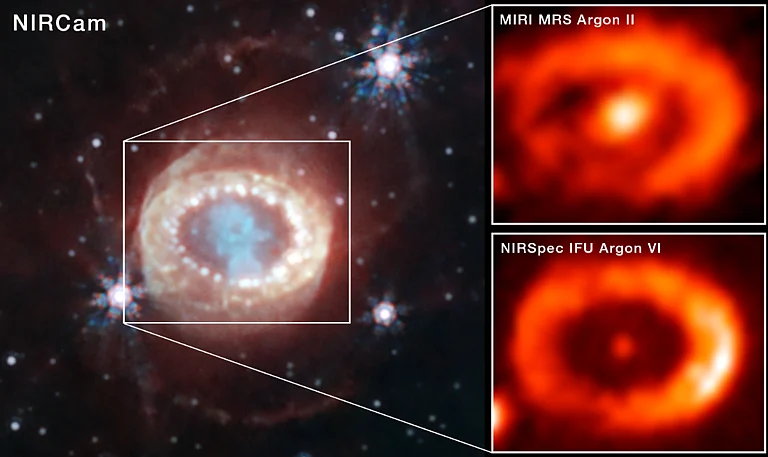In a major development in the realm of space research, a team of solar physicists led by researchers from the Pune-based National Centre for Radio Astrophysics (NCRA), has succeeded in capturing exceptionally detailed radio images of the Sun through the very efficient MeerKAT radio telescope in South Africa.
NCRA Scientists Capture Exceptionally Detailed Solar Images Using MeerKAT Radio Telescope | Details Inside
MeerKAT, the radio telescope located in South Africa's Karoo desert, is known to be a precursor to the mid-frequency telescope of the Square Kilometre Array Observatory (SKAO). In a bid to get clearer images, the NCRA scientists deployed the theory of seeing an object using peripheral vision. They pointed the telescope at a small distance from the Sun instead of pointing it directly at the Sun.

Despite appearing as the brightest and the most conspicuous celestial object in the sky seen from the Earth, which has been studied since the earliest of times, several mysteries around the central character of our solar system are yet to be unravelled.
What is MeerKAT?
South Africa's MeerKAT radio telescope, also known as the Karoo Array Telescope, is located in the Karoo desert. MeerKAT is known to be a precursor to the mid-frequency telescope of the Square Kilometre Array Observatory (SKAO). Besides MeerKAT, the SKAO also has three other precursors including the Hydrogen Epoch of Reionization Array (HERA), also in South Africa, two radio telescopes in Western Australia, the Australian SKA Pathfinder (ASKAP) and the Murchison Widefield Array (MWA).
MeerKAT houses 64 radio dishes, each with a diameter of 13.5 m, distributed across an eight km radius.
Despite being the best-suited telescope in the world designed to capture the spectroscopic and snapshot images of the Sun with high fidelity at GHz frequencies, the astronomers still encounter several challenges in making these high-fidelity spectroscopic solar images using MeerKAT.
The research and the researchers
In a bid to observe the Sun closely, the researchers this time adopted a non-standard observing strategy. Deploying the theory of seeing an object using our peripheral vision, the scientists pointed the telescope at a small distance from the Sun instead of pointing it directly at the Sun.
However, despite allowing the researchers to observe the Sun with MeerKAT, this technique led to additional problems in making the high-fidelity images.
The team of researchers was led by Dr. Devojyoti Kansabanik along with Dr Surajit Mondal. Both of them have completed their PhD from the National Centre for Radio Astrophysics, Tata Institute of Fundamental Research (NCRA-TIFR), Pune, under the supervision of professor Divya Oberoi from NCRA.
After finishing doctoral research, Dr Kansabanik has recently received the NASA Jack Eddy postdoctoral fellowship at the Applied Physics Laboratory of the Johns Hopkins University, USA while Dr Mondal is now a postdoctoral fellow at the Centre for Solar Terrestrial Research of the New Jersey Institute of Technology, USA.
What did the scientists say?
According to Dr Kansabanik, the lead author of this study, “The Sun is, in fact, a surprisingly challenging source to study, especially at radio wavelengths.” The radio emissions arise from the tenuous atmosphere of the Sun - a region known as the corona and visible to the naked eye only during times of total eclipse. The corona is the birthplace of the phenomena that impact the Earth’s environment; something we now refer to as Space weather.”
Dr Surajit Mondal said, “For imaging the Sun, there are several complications. One is that not only does the emission change very quickly in time, but it can also change dramatically from one wavelength to a nearby wavelength. For the Sun, this results in the images being blurry, much like a fast-moving car appears blurry in typical photos. To deal with this, one not only has to make movies with a large frame rate, but also do it for a large number of wavelengths to build a detailed picture of what is happening in the solar atmosphere.”
Dr Kansabanik further said, “We put in lot of effort into understanding the effects of the instrument and the peripheral vision due to unconventional observing mode. We developed algorithms to estimate and correct the effects of both the instrument and peripheral vision.”
“To evaluate the fidelity of the images, we compared them with simulations and found excellent similarities” Dr Kansabanik added.
-
Previous Story
 ‘None Of You Will Escape’: Jaipur Hospitals Receive Threat Mails, Bomb Disposal Squads Dispatched
‘None Of You Will Escape’: Jaipur Hospitals Receive Threat Mails, Bomb Disposal Squads Dispatched - Next Story









.jpg?auto=format%2Ccompress&fit=max&format=webp&w=376&dpr=2.0)











